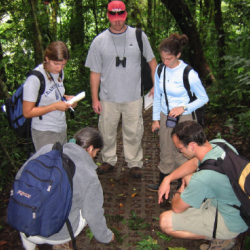Source Institutions
Source Institutions
Add to list Go to activity

In this activity, learners survey living organisms near where they live or go to school, and create a local field guide. Learners discover the value of conducting long-term observations of an ecosystem as the best way to understand how all of its parts work together. Working individually or together, learners hunt for organisms under rocks, between bushes, in shaded corners, etc., to identify at least five items in four categories of living organisms, such as birds, plants, and insects and note their characteristics and behaviors. This activity can be found on pages 16-17 of the activity guide. [Activity is publicly available through a web crawler capture on Archive.org.]
- 30 to 45 minutes
- 30 to 45 minutes
- $1 - $5 per group of students
- Ages 6 - adult
- Activity, Field Trip
- English
Quick Guide
Materials List (per group of students)
- Worksheet – Creating a Local Field Guide
- Worksheets – Local Field Guide templates
- Clipboard and pencils
- Binoculars (optional)
- Magnifying lenses (optional)
- Field guides for birds, insects, flowers and trees for reference
Subjects
-
Life Sciences
-
Diversity of Life
- Plants
- Animals
-
Ecology
- Ecosystems
-
Diversity of Life
-
The Nature of Science
-
The Scientific Process
- Gathering Data
- Formulating Explanations
- Communicating Results
-
The Scientific Process
Informal Categories
- Animals
- Nature and Environment
- Outdoor Activity
- Physical Activity
Audience
To use this activity, learners need to:
- see
- see color
- read
- hear
- be mobile
Learning styles supported:
- Involves teamwork and communication skills
- Involves hands-on or lab activities
Other
Access Rights:
- Free access
By:
Source Collection
- Science After School Consumer's Guide
Rights:
- All rights reserved, TERC, 2007
Funding Sources:
- NASA, NAS5-26555
- National Science Foundation, NSF 9730728
